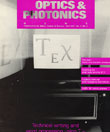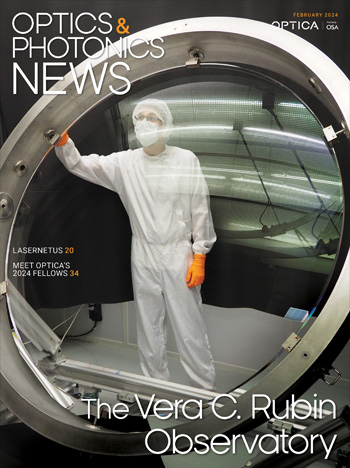
April 1991 Issue
- Technical writing and word processing using TeX
- Reaching the Shot Noise Limit For $10
- Hubble: Looking for answers
- Hubble: Looking for the trouble
- Hubble: A mirror up to (human) nature
- Standards writing as market research
- Liquid crystals: Unusual materials with a picturesque future!
- The Laser Medicine's Troubled Adolescent
- Browse all Issues
Feature Articles
Technical writing and word processing using TeX
If you write technical papers or prepare manuscripts containing any significant amount of mathematics, you want to learn and use TEX. That's the bottom line of this article. TEX-nically speaking (and that's how "TEX" is pronounced), TEX is not a conventional word processor or text editor. Rather, it's a typesetting language. As such, it is a superb tool for preparing journal articles, long technical reports, and even entire books (my 1300-page Lasers book was done entirely in TEX). It has especially powerful capabilities for typesetting mathematics. But once you begin working with TEX, you will use it for a great many other things. You can write letters with your own letterhead and logo included in a predefined template; prepare slides and overhead transparencies directly from your manuscripts; compose flyers and announcements; and accomplish any other task that involves putting letters and ink marks on paper.
by A. E. SiegmanReaching the Shot Noise Limit For $10
Laser-based optical measurements are a fundamental technology of our civilization. Their flexibility is amazing: interferometers maintain the accuracy of machine tools, serve as gyroscopes for navigation, do transform spectroscopy, and perform ranging for seismology and gravity wave detection; lidar detects tornadoes, wind shear, and air pollution; other systems play compact disks and scan bar codes in supermarkets. Optical measurements in research include spectroscopy, Doppler velocimetry, aerosol particle monitoring, ellipsometry, interferometry, fiber-based sensing, femtosecond pump/probe studies, and many, many more.
by Phillip C. D. HobbsHubble: Looking for answers
The Hubble Space Telescope consists of a large aperture diameter Cassegrain Telescope, called the Optical Telescope Assembly (OTA, for short, as NASA loves acronyms). This optical system feeds images to a variety of sensors that include cameras and spectrographs clustered about the focal plane of the OTA. The entire telescope assembly resides within a guidance and control spacecraft that uses information from optical sensors to provide the extremely fine pointing stability required for observation of faint objects. Since the telescope is in orbit, the optics should be nearly perfect to take maximum advantage of the absence of atmospheric limitations encountered by ground-based telescopes.
by R.R. ShannonHubble: Looking for the trouble
Although the problem with the Hubble Space Telescope can be pinpointed to a single error, a look at the bigger picture shows that the difficulty was much more complex. Many unforeseen yet interrelated design, management, and schedule conflicts contributed to the error. While it would make a fascinating story to conjecture on these matters, here we address the logical steps taken to find the error.
by Robert E. ParksHubble: A mirror up to (human) nature
One of my most vivid recollections of following the Hubble Space Telescope program for several years is a briefing by a Perkin-Elmer representative. The briefer was smoothly flipping his chart and, as usual, we were hearing how well things were going. At one point, however, a member of the audience rather sheepishly questioned a claim that a component "exceeded specification." Surely, the real meaning of the chart was that the component failed specification? "That's right," the briefer asserted, "it exceeds specification in a negative direction." And he pressed confidently along.
by Robert W. SmithStandards writing as market research
Now that an ANSI accredited optical standards infrastructure has been established as ANSI PH3.OP, it needs support in the form of dues and technically skilled personnel. Those who make optical instruments stand to benefit from their efforts. In fact, the marketing departments of optical manufacturers have much to gain and, thus, should contribute a large share of that support. At first glance, this suggestion may not make sense. What good is ANSI PH3.OP to marketing professionals? Consider a case in point. Several manufacturers of phase measuring interferometry (PMI) equipment have independently raised the question of "How should a peak-to-valley error be defined?". Should 100% of the tens of thousands of possibly noisy data points be considered or some slightly smaller fraction? And what if different manufacturers decide on different percentages?
by Robert E. ParksLiquid crystals: Unusual materials with a picturesque future!
Liquid crystal materials are appearing more and more frequently in our lives. In particular, liquid crystal displays (LCDs) are becoming more and more common. They are used to present information to us in a variety of applications, ranging from showing time on a digital wristwatch to full color TVs that use liquid crystals to generate their pictures. The application of liquid crystal displays is a good example of modern technology that can be explored with young people. This article presents ways to explain and demonstrate some of the important concepts involved in this technology.
by Steven E. ShieldsThe Laser Medicine's Troubled Adolescent
From the beginning, the laser's medical potential charmed the medical community and the public alike. Its ease of operation, quickness, and precision offer an unprecedented alternative to conventional protocols. But, all learned quickly that without strict clinical trials and thoughtful application, the laser would join other junked prototypes on the shelf. "Five or six years ago, physicians were extremely naive," says Ann Coulter, who's followed the medical laser market for Market Intelligence Research Corp. "Now, physicians are very realistic about what lasers can do."
by Susan M. Reiss
![A multiplexed image of a human tonsil acquired. [NIAID] using the iterative bleaching extends multiplexity (IBEX) method.](https://opnmedia.blob.core.windows.net/$web/opn/media/images/articles/2024/0424/departments/202404-cover-web.jpg?ext=.jpg)

